#Rana Hatun
Explore tagged Tumblr posts
Text
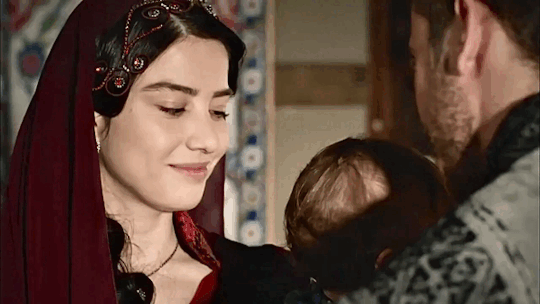

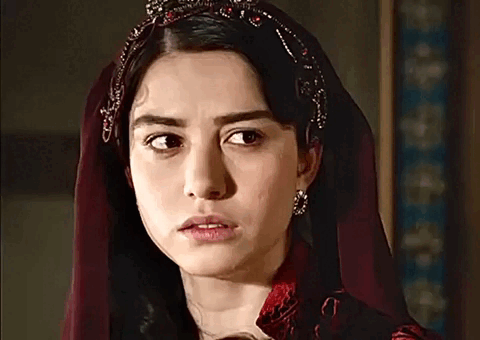
ꨄ Rana Sultan (Özge Gürel) — Magnificent Century Ep.114
#rana sultan#rana hatun#gifs#magnificent century#muhteşem yüzyıl#muhtesem yuzyil#özge gürel#ozge gurel
21 notes
·
View notes
Text











This red and black cloak is first worn by Aybige Hatun's lady-in-waiting in the twentieth episode of the second season of Magnificent Century. The cloak is then seen on Aybige Hatun in the thirty-first episode. Three episodes later, it appears again on Hatice Sultan. The cloak is then worn by Rakel Hatun in the thirthy-eighth episode of the same season. It briefly appears on Fatma Sultan in the third episode of the fourth season. It is seen next on Rana Sultan in the twelth episode. Despite the lighting being rather dark, the cloak is also recognizable on Fidan Kalfa in twentieth episode.
After this use, the cloak was altered as the neckline is slightly different and the hood appears to be missing. This new version is debuted by Mihrimah Sultan in the thirty-fourth episode of the fourth season.
The cloak appears again on Yasemin Hatun in the twenty-first episode of the first season of Magnificent Century: Kösem. Dilruba Sultan also wears it in the thirtieth episode, however the hood appears to have been reattached to the cloak. The cloak makes another appearance on Zarife Hatun in the twenty-fifth episode of the second season.
This post is an updated version of an older post.
#Muhteşem Yüzyıl#Muhteşem Yüzyıl: Kösem#Magnificent Century#Magnificent Century Kösem#Magnificent Century Kosem#period drama#costume drama#historical drama#Aybige Hatun#Hatice Sultan#Hatice Sultan (Daughter of Hafsa)#Rakel Hatun#Fatma Sultan#Fatma Sultan (Daughter of Hafsa)#Rana Sultan#Fidan Kalfa#Fidan Hatun#Mihrimah Sultan#Mihrimah Sultan (Daughter of Hürrem)#Yasemin Hatun#Dilruba Sultan#Zarife Hatun#Unnamed Harem Members#reused costumes#recycled costumes
16 notes
·
View notes
Photo










Magnificent Century Season 4 + Mothers & Sons
#Muhteşem Yüzyıl#Magnificent Century#mcedit#perioddramaedit#weloveperioddrama#period drama#perioddrama#MCPlus#MC S4 Mothers Sons#HistoricalDramasPlus#Muhtesem Yuzyil#wspaniałe stulecie#Hurrem Sultan#Great Prediction#New Sanjack-bey of Manisa#Another Sister of the Sultan#The Secrets of Fatma Sultan#The Offensive#Rana Hatun#Mahidevran Sultan#Awkward-Sultana
64 notes
·
View notes
Text
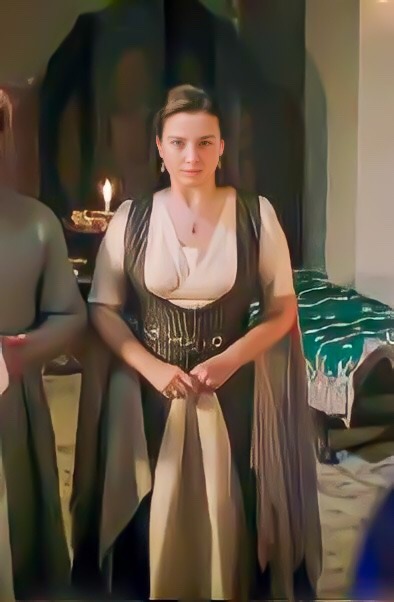
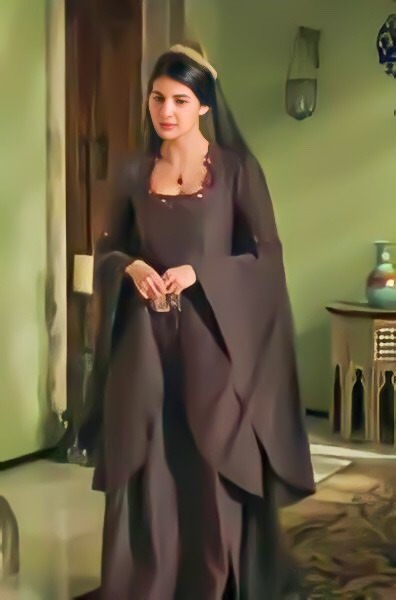


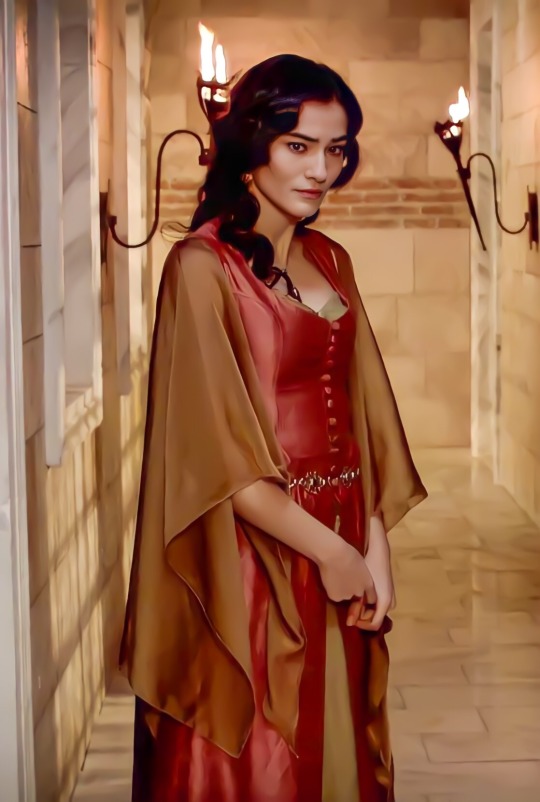



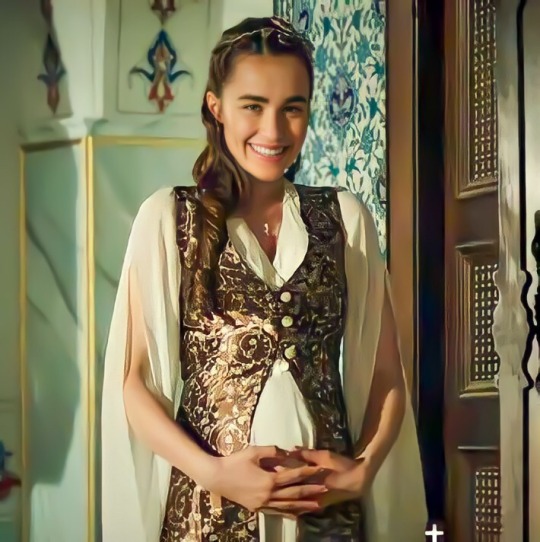

Hatuns promo pics part 3
#costume drama#every episode#costume#muhtesem yuzyil#magnificent century#every hatun costume#rana hatun#Ayse hatun#rümeysa hatun#Fatma hatun#dilsah hatun#gulsah hatun#gulnihal hatun#fidan kalfa#Sadika hatun#hatuns
24 notes
·
View notes
Photo






Some shots of Rana Hatun being a lovely mother.
5 notes
·
View notes
Text
Non real life sultanas
A little Christmas surprise post comes. One of my most popular videos on Youtube was the one, where I gathered non-historical characters, explaining how fictional or how historical they were, and if there was a real historical person behind them as an inspirer. Now, for Christmas, I would like to summarize for you the main fictional characters of the Muhteşem Yüzyil series.
Several fictional characters were present in the Muhteşem Yüzyil series, many from the very first minutes. The presence of some fictional characters was forgivable, as we were left with very little detailed information about the harem of Sultan Suleiman I. Thus, for example, the characters of Sümbül Agha, Gül Agha, Mercan Agha, and other eunuchs, although not portraying historical characters, were necessary for the dramaturgy of the series. Sümbül's character was the most important among the eunuchs and perhaps this is why many of us may think that Hürrem actually had such a close friend in the person of the chief eunuch. However, this is not true. During Suleiman's reign, many chief eunuchs took turns, and none of them were known to be particularly close to Hürrem. Of Hürrem's close servants, only one is known by name, a woman named Nevbahar. The characters of Nigar Kalfa, Gülsah Hatun, Fidan Hatun, Daye Hatun, Fahriye Kalfa were similar to Sümbül. None of them were historical, but surely every sultana had their own trusted servants, as they showed in the series. Like the eunuchs and kalfas, the concubines of Prince Mustafa and Prince Bayezid, Ayşe, Rana, Defne or Rumeysa Hatun, can also be considered forgivable fictional characters. We do not know anything about the harem of the two princes as neither of them had a major consort and as their children were born from different women.
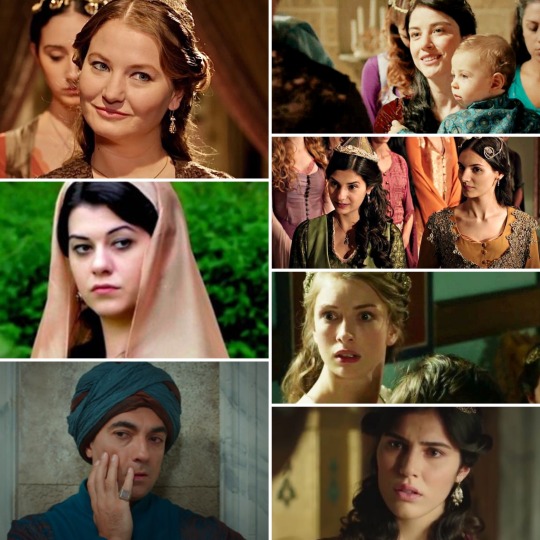
However, there were also characters who were written into the story just for the sake of the drama. Which of these characters was acceptable is up to everyone and feel free to write your opinion about them in a comment here or on another platform! So here's the long-awaited list:
Sadika Hatun
Sadika was a Hungarian woman in the series whose husband was killed by Sultan Suleiman on the day of their wedding. Sadika then became the spy of the Hungarian king, Lajos II and she traveled to Istanbul to personally avenge her husband’s death. Matrakci Nasuh Efendi then, by chance, meets the girl and helps her get into the harem, where she immediately joins Ayşe Hafsa Valide Sultan's service and then becomes Hatice Sultan’s chief servant. During her job, of course, she gets close to Suleiman's bed several times, and then she had the opportunity to attack the sultan. However, she does not succeed, Suleiman survives, and Sadika is thrown in the Bosphorus.
In reality, this story would not be possible at all. Even if we assumed that Sadika really existed and Suleiman actually killed her husband, she would not have been able to get into the Sultan's harem and take revenge. On the one hand, Sadika was already a married woman, an adult woman. Such women could not enter the harem, only virgin, child girls could become the sultan's later concubines. However, even if Sadika had somehow been able to get in the harem, a long education would have awaited her before she could join the Valide Sultan's service. While there may have been some exceptional cases where older or non-virgin women wanted to be gifted to the Sultan, these are special cases. Such was the case, for example, when Hayreddin Barbarossa wanted to kidnap the beautiful Giulia Gonzaga, a widowed Italian noblewoman known far and wide, to send her to the Sultan's harem as a gift. In the end, he didn’t succeed, but even if he did, we don’t know if the sultan would had ever taken the woman to his bed.
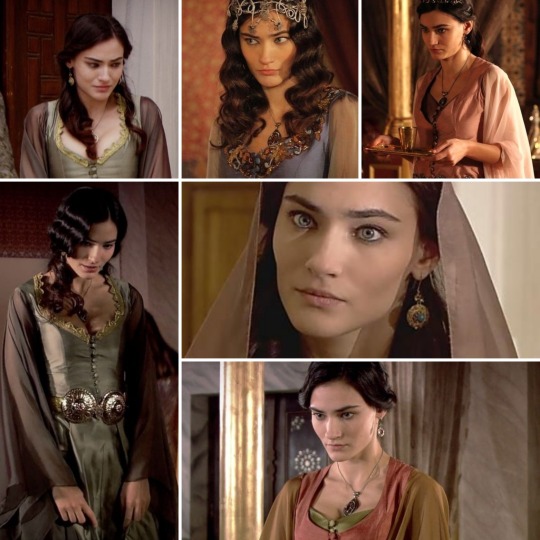
Leo
In the series, he was the love of Hürrem from their youth. Leo came to Istanbul with the goal of finding her former sweetheart. Leo is a talented artist who, with the help of Nasuh Efendi (ahh Nasuh brought all the good people near to the Sultan…) will become the painter of Sultan Suleiman and Pargali Ibrahim. His former relationship with Hürrem will soon be revealed to Pargali Ibrahim, who is thus trying to blackmail Hürrem. Hürrem repeatedly begs Leo to leave the capital, but the man remains, which eventually leads to his death.
In reality, Hürrem - and all the other concubines - were taken into Ottoman captivity as little girls, so it is out of the question that they would have had a love or a fiance. And even if they had, they could never have found them. Nasuh Efendi, though one of the greatest suckers in the series - yet the dearest character - was not like that in reality at all, but he was a wonderful scholar who, by the way, was not so closely friends with either Sultan Suleiman or Pargali Ibrahim.
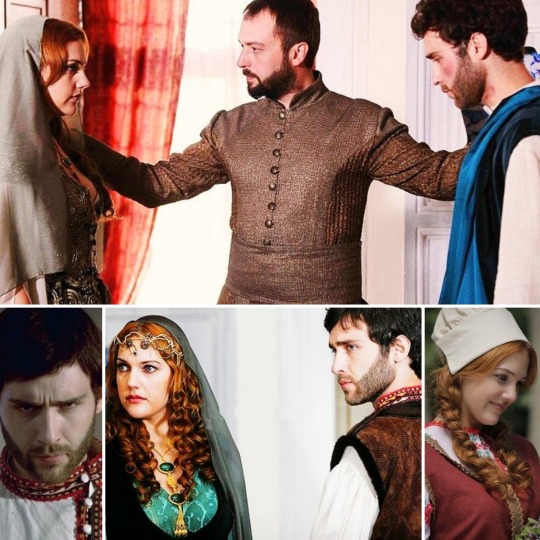
Princess Isabella
Princess Isabella Fortuna was a Spanish noble lady in the series who was on a ship to her future husband, the Austrian prince, when she was captured by Ottoman pirates and was taken to Istanbul to Sultan Suleiman. At first, Suleiman was only interested in the princess for political reasons, but later he fell in love. Princess Isabella initially resisted Suleiman's approach with all her cartilage, but over time she fell in love with the sultan and became his lover. This, of course, Hürrem could not stand and did everything she could to get rid of the princess who was eventually sent home by Suleiman himself.
In reality, of course, such a situation would have been unthinkable. Even assuming that Isabella existed and was captured by pirates, no princess raised in the Catholic faith would have voluntarily become the concubine of a Muslim sultan, she would have committed suicide instead. Let us not forget that Suleiman was loyal to Hürrem from the 1520s onwards, so in reality there was not a single woman who could make hard time for Hürrem during her decades-long relationship with Suleiman. Isabella Fortuna, on the other hand, never existed. Surprisingly, however, they could have patterned her from a real character. There was an Isabella of Castile in this period who was born in 1518 as the child of the widowed Queen of Aragon, Germaine of Foix and Charles V, but she was never captured by Ottoman pirates and was never the bride of the Austrian prince. Isabella's existence was kept secret by her parents all her life, only her mother's testament revealed that she ever existed. It is also known from there that Isabella died young in 1537.
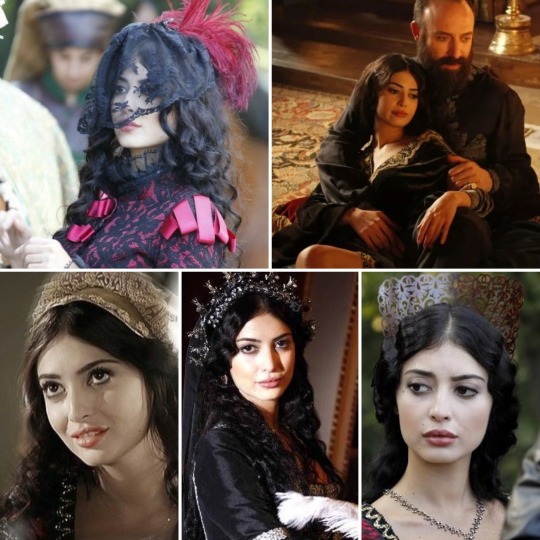
Aybige Hatun
In the series, Aybige was the niece of Ayşe Hafsa, and so the daughter of the Crimean Sahib Giray khan. Aybige originally only came to visit her aunt in Istanbul, but later Hafsa Sultan wanted to see her as the wife of her favorite grandson, Prince Mustafa. However, Aybige was in love with Bali Bey and Mustafa longed for someone else aksi. Bali Bey was eventually almost executed for their love, and Aybige returned to Crimea with her father in the end.
Aybige’s storyline makes mistakes at almost every point. First, Ayşe Hafsa was never the sister of the Crimean khan, so the daughter of the Crimean khan could not have been her niece either. In addition, although Sahib Giray Khan had several daughters, none were called Aybige and none of his daughters ever traveled to Istanbul. The only true point in the whole storyline is that Sahib Giray Khan really collaborated with Sultan Suleiman in his Moldovan war. It is also important to mention Bali Bey at this point. Although Bali Bey was a real historical figure, there is not the slightest match between historical Bali Bey and the series Bali Bey. The real Bali Bey was not a romantic guy who fell in love with every second woman. Bali Bey was a cruel warlord. And if it comes to Bali Bey, let’s say a few words about Prince Mustafa as well. The idea of wanting to marry Mustafa to a khan’s daughter is completely absurd! Since the reign of Sultan Mehmed II, princes have been forbidden to marry anyone, so Prince Mustafa has not been allowed to marry anyone either. And the fact that Suleiman would have supported the idea - even if such a marriage had been able to occurre at all - is an even greater absurdity. Suleiman did not want Mustafa as his heir, so he would never have given him as much power as the support of the Crimean khan.
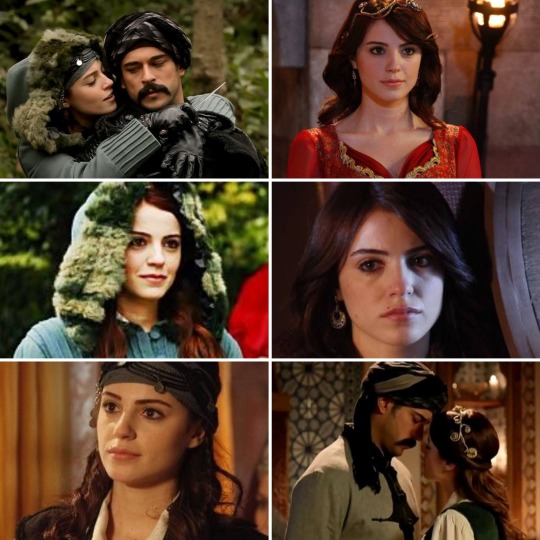
Firuze Hatun
In the series, Firuze was a Persian spy who, with her amazing abilities, was able to heal the pains of the sick Prince Cihangir, earning the love of Hürrem Sultan. Firuze, however, thanked Hürrem kindness in a disgusting way, and became Suleiman's secret lover, whom the sultan fell in love with. In the end, Hürrem was only able to overcome Firuzen with a little, Firuze was eventually exiled from the palace so she could return to Persia.
In reality, Suleiman was loyal to Hürrem, living in a monogamous relationship with her. Even if there was an occasional one-night-stands, Suleiman never fell in love with another woman, only Hürrem. Thus, the Firuze storyline has already failed here. The fact that there was a Persian spy in the harem would have been an interesting suggestion though. There were certainly spies in the royal court of every empire, but they were probably not hiding among the concubines. Eunuchs, for example, moved with much greater freedom, were much better candidates for being a spy…
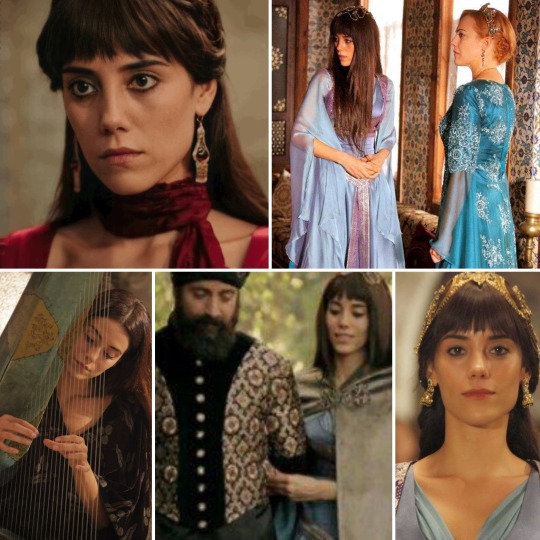
Huricihan Sultan
In the series, Huricihan was the daughter of Ibrahim Pasha and Hatice Sultan, who grew up in the palace of Beyhan Sultan after the death of her parents. From there she returned to Istanbul, where she fell in love with her first cousin, Prince Bayezid. Their love became a relationship and then marriage without the Sultan’s permission. Huricihan became the head of Bayezid's harem and soon her relationship with Hürrem and Suleiman slowly became better. Huricihan's end eventually was brought by Prince Selim's concubine, Nurbanu, who knocked her out in the heat of a dispute, killing her.
In reality, Hatice and Ibrahim Pasha were never married, so they didn't have children either together, so Huricihan never existed. If she had existed, for the reasons already mentioned, it would have been utterly inconceivable for Bayezid to marry her, either secretly or openly. Especially knowing that Bayezid had never had a favourite singled out concubine, as all of his children were born to different women. With a background like this, it’s unlikely he’d ever wanted to marry anyone. Although Hatice Sultan did indeed have a daughter, she was born between 1510 and 1515, so she was well ahead of Bayezid in age, and of course she had nothing to do with the prince and was not even called Huricihan.
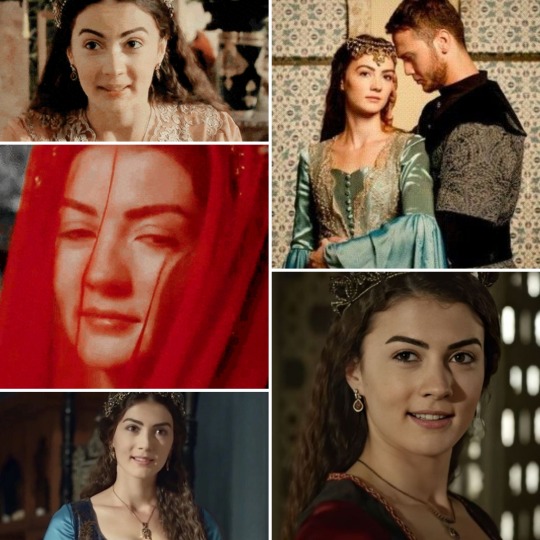
Mihrünissa Hatun
In the series, Mihrünissa was the daughter of Hayreddin Barbarossa the Head of the Fleet, whom her father sent to Prince Mustafa as a consultant. Later, the two young person fell in love with each other and married without the Sultan's knowledge. In time, Mihrünissa also gave birth to Mustafa's son Mehmed. After Prince Mustafa and his son Mehmed were executed, Mihrünissa went to the capital and cut her own throat before Hürrem's eyes.
In reality, for the reasons already detailed several times above, no prince could marry anyone, so Mustafa also never married. In addition, Barbarossa never had a daughter named Mihrünissa and Hayreddin Pasha was never a supporter of Prince Mustafa. However, even assuming that Mihrünissa existed, there is no chance that she could have committed suicide before Hürrem's eyes. Prince Mustafa's harem retired to Bursa, so that no member of the harem could travel to the capital, especially not to the palace and kill herself in front of Hürrem. So, in fact, the Mihrünissa storyline was just 100% fiction.
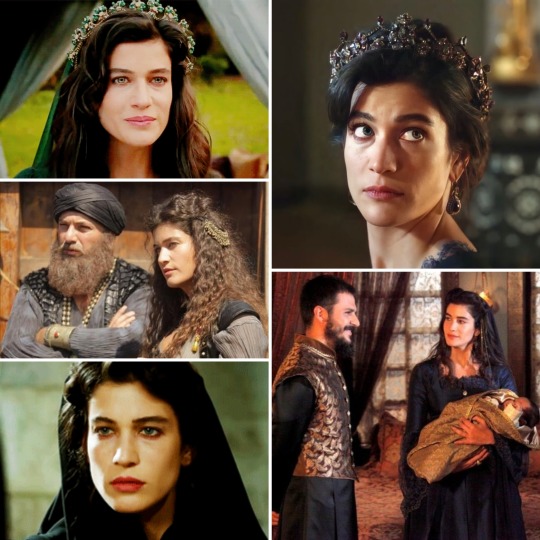
Nazenin Hatun
In the series, Nazenin arrived in Istanbul with Nurbanu, where Hürrem, who was struggling with menopause, sent her to the sultan herself. Nazenin thus became the sultan's concubine and soon gave birth to a daughter, Raziye Sultan. Eventually, on Hürrem's instructions, she was killed by Nurbanu.
In reality, as I have said many times, Suleiman was loyal to Hürrem. In addition, after the birth of Prince Cihangir in 1531/2, Suleiman had no more children, neither to Hürrem nor to anyone else. It is true that he had a daughter named Raziye, however, the child died in 1520 at the age of a few years as a result of an epidemic.
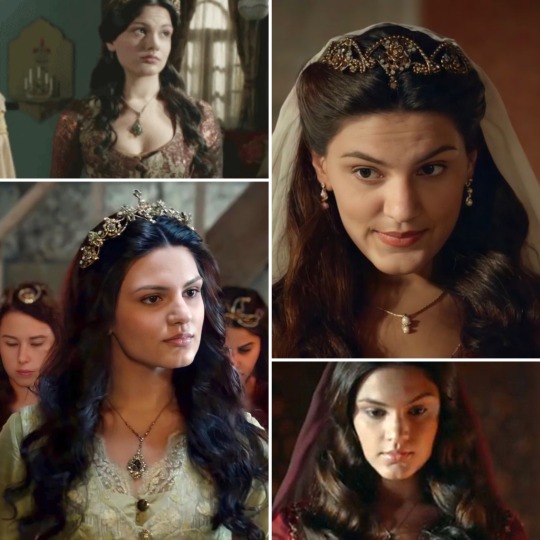
Surprising realities
After many fictional characters, one would think that all eunuchs and kalfas were fictional characters, as we know quite a bit about the harem. However, this is not true! There were some historically inspired characters, such as Gazanfer Agha, who, although existed and was one of the most influential eunuchs ever, was not a loyal man of Nurbanu, but Sultan Selim II. Gazanfer reached the peak of his career, by the way, during the reign of Safiye Sultan.
Similarly historical was Canfeda Hatun, who was Nurbanu’s most loyal servant and one of the most influential kalfas of her era. True, Canfeda’s character in the series was a fusion of two loyal servants of historic Nurbanu. In her young age, in the princely harem of Selim, Nurbanu became acquainted not with Canfeda but with another kalfa, who remained her faithful servant for the rest of her life. Canfeda only became Nurbanu’s main supporter during Selim’s reign.
Like them, Afife Hatun’s character was partly real also. Sultan Suleiman's wetnurse was really called Afife and the sultan always kept in touch with the woman. However, Afife Hatun never moved to Istanbul to rule the Sultan’s harem, but lived a simple life.
Gracia Mendes Nasi was introduced last season as a wealthy Portuguese Jewish woman who helped Portuguese refugees get to Istanbul. Later, Gracia became the lover of Grand Vizier Rüstem Pasha, which made her an enemy of Mihrimah Sultan. In reality, Gracia Mendes was a very benevolent soul who was committed to Jewish traditions and her Jewish brothers. She was never a lover of Rustem and an enemy of Mihrimah. However, like the series, Gracia actually enjoyed the Sultan’s support and, with his help, she made great improvements in Istanbul’s Jewish Quarter and helped many refugees start a new life in the Ottoman Empire.
One of the most interesting guest actors of the last season of the series was Anna Jagello, the daughter of the former King of Poland, the sister of the new King of Poland. Although the woman was a real historical figure, the historical Anna never traveled to Istanbul and never corresponded with Hürrem Sultan. However, Hürrem exchanged letters several times with Anna's mother Bona Sforza, Anna's father, King Sigismund I of Poland, and Anna's brother, the later Zsigmond Ágost II king of Poland, and even Anna's sisterm Isabella, the Hungarian queen. Thanks to the intercession of Hürrem, the relationship between the Kingdom of Poland and the Ottoman Empire was quite good and almost friendly during Suleiman's reign.
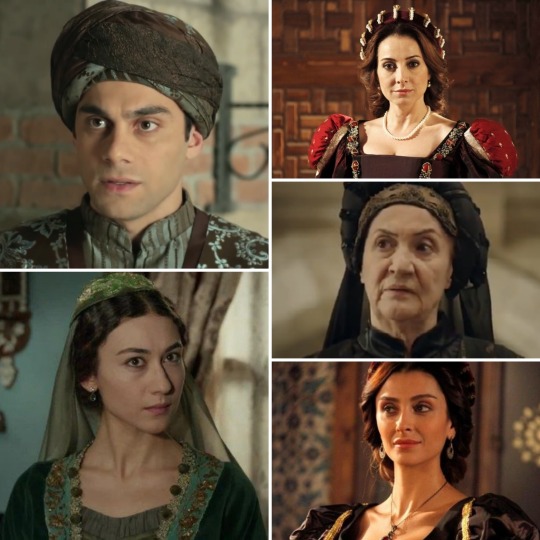
* * *
Egy kis karácsonyi meglepetés poszt következik. Youtube-on az egyik legnépszerűbb videóm az volt, amelyben a nem történelmi karaktereket gyűjtöttem össze, elmagyarázva, mennyire voltak kitaláltak, mennyire volt mögöttük egy-egy valós történelmi személy, mint ihlető. Most karácsony alkalmából szeretném nektek összefoglalni a Muhteşem Yüzyil sorozat főbb kitalált karaktereit és történetüket.
A Muhteşem Yüzyil sorozatban több kitalált karakter is jelen volt, sokan már az első percektől kezdve. Egyes kitalált karakterek jelenléte megbocsátható volt, hiszen nagyon kevés részlet maradt ránk a Szulejmán háremében jelenlévő személyekről. Így például Sümbül Aga, Gül Aga, Mercan Aga és más eunuchok karakterei bár nem valódi személyeket keltenek életre, szükségesek voltak a sorozat dramaturgiája szempontjából. Sümbül karaktere volt a legfontosabb az eunuchok között és talán emiatt sokan gondolhatjuk úgy, hogy Hürremnek a valóságban is volt egy ilyen közeli barátja a fő eunuch személyében. Azonban ez nem igaz. Szulejmán uralkodása alatt rengeteg főeunuch váltotta egymást és egyikről sem ismert, hogy különösebben közel álltak volna Hürremhez. Hürrem közeli szolgálói közül csupán egy ismert név szerint, egy Nevbahar nevű nő. Sümbülhöz hasonló volt Nigar Kalfa, Gülsah Hatun, Fidan Hatun, Daye Hatun, Fahriye Kalfa karaktere is. Egyikük sem valós személy volt, ám bizonyosan minden szultánának megvoltak a saját megbízható szolgálói, ahogy ezt a sorozatban is mutatták. Hasonlóan az eunuchokhoz és kalfákhoz megbocsátható füllentésnek tekinthetőek Musztafa herceg és Bayezid herceg ágyasai is, Ayşe, Rana, Defne vagy Rumeysa Hatun. A két herceg asszonyairól ugyanis semmit sem tudunk, egyiküknek sem volt kiemelt jelentőségű főágyasa, gyermekeik más-más nőktől születtek.
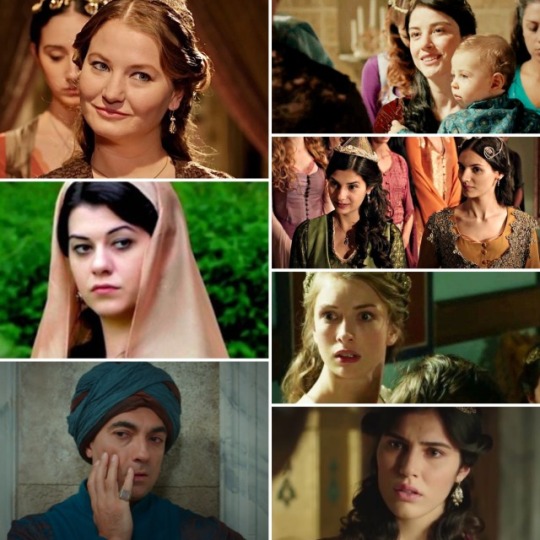
Voltak azonban olyan karakterek is, akiket csupán a dráma kedvéért írtak bele a történetbe. Az, hogy ezek közül melyik karakter mennyire volt elfogadható, azt mindenki maga döntse el és nyugodtan írja meg kommentben itt vagy más platformon, hogy mit gondol róluk! Következzék hát a várva várt lista:
Sadika Hatun
Sadika a sorozatban egy magyar nő volt, akinek férjét az esküvőjük napján megölte Szulejmán szultán. Sadika ezek után a magyar király, II. Lajos parancsára Isztambulba utazott, hogy ott személyesen bosszulja meg férje halálát. Matrakci Nasuh Efendi aztán egy véletlen folytán megismerkedik a lánnyal és segít neki bekerülni a hárembe, ahol azonnal Ayşe Hafsa Valide Sultan szolgálatába áll, majd Hatice Sultan főszolgálója lesz. Menetközben természetesen többször is Szulejmán ágyának közelébe kerül, majd lehetősége nyílik a szultánra támadni. Azonban nem jár sikerrel, Szulejmán életben marad, Sadikát pedig a Boszporuszba fojtják.
A valóságban ez a történetszál egyáltalán nem lenne lehetséges. Ha feltételeznénk is azt, hogy Sadika valóban létezett és Szulejmán valóban megölte a férjét, akkor sem állt volna módjába bejutni a szultáni hárembe és bosszút állni. Egyrészt Sadika férjezett asszony volt már, felnőtt nő. A hárembe nem kerülhettek be ilyen nők, csupán szűz, gyermeklányokból válhattak a szultán ágyasai. Mindazonáltal ha Sadika valahogy mégis bekerült volna a hárembe hosszadalmas oktatás várt volna rá, mielőtt a Valide Sultan szolgálatába állhatott volna. Előfordulhatott ugyan néhány kivételes eset, amikor idősebb vagy nem szűz nőket akartak volna a szultánnak ajándékozni, azonban ezek különleges esetek. Ilyen volt például, amikor Hayreddin Barbarossa el akarta rabolni a messze földön ismert, gyönyörű Giulia Gonzagát, megözvegyült itáliai nemesasszonyt, hogy a szultán háremébe küldje ajándéknak. Végül nem járt sikerrel, ám ha sikerrel járt volna is, nem tudni, hogy a szultán valaha is ágyba vitte volna-e a nőt.
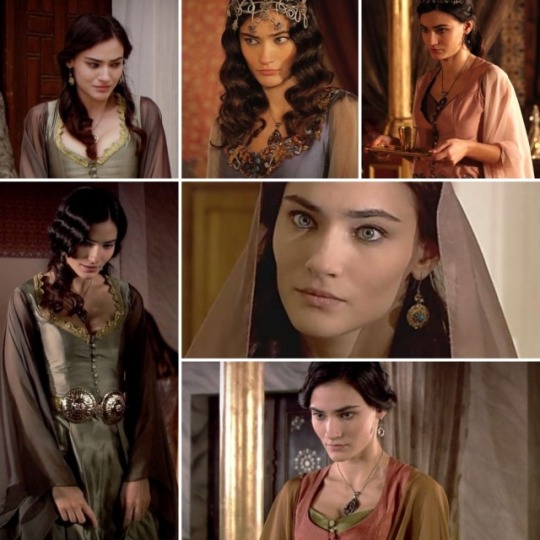
Leo
A sorozatban Leo Hürrem fiatalkori szerelme volt, aki azzal a céllal érkezett Isztambulba, hogy megtalálja egykori kedvesét. Leo tehetséges művész, aki Nasuh Efendi segítségével (ahh Nasuh csupa jó embert juttatott a szultán közelébe…) Szulejmán szultán és Pargali Ibrahim festője lesz. Egykori viszonya Hürremmel hamarosan kiderül Pargali Ibrahim számára, aki ezzel próbálja zsarolni Hürremet. Hürrem többször könyörög Leonak, hogy hagyja el a fővárost, de a szerelmes férfi marad, ami végül halálához vezet.
A valóságban Hürrem – és minden más ágyas – még kislányként került oszmán fogságba, tehát kizárt, hogy szerelmük vagy vőlegényük lett volna, ha pedig mégis, az sosem tudott volna rájuk találni. Nasuh Efendi, pedig aki a sorozat egyik legnagyobb baleke – ugyanakkor legkedvesebb karaktere – a valóságban egyáltalán nem ilyen volt, hanem egy csodálatos tudós, aki egyébként nem állt ilyen közeli barátságban sem Szulejmán szultánnal, sem Pargali Ibrahimmal.
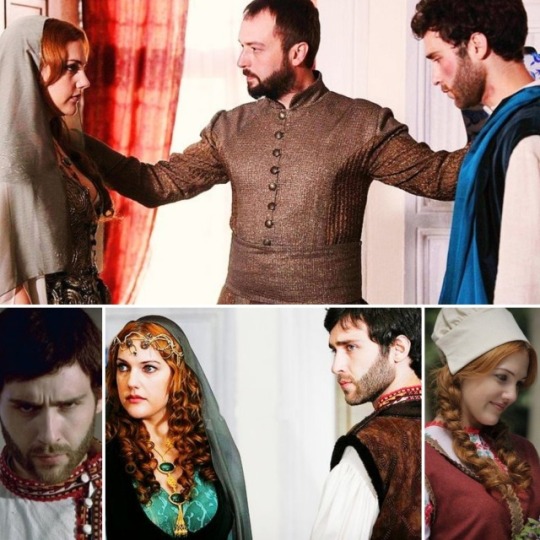
Izabella Hercegnő
Izabella Fortuna hercegnő a sorozatban egy spanyol nemes hölgy volt, aki éppen jövendőbeli férjéhez, az osztrák herceghez tartott hajón, mikor az oszmán kalózok elragadták és Isztambulba vitték Szulejmán szultán elé. Először Szulejmán politikai okokból érdeklődött csupán a hercegnő iránt, később azonban beleszeretett. Izabella hercegnő eleinte minden porcikájával ellenállt Szulejmán közeledésének, idővel azonban beleszeretett a szultánba és a szeretője lett. Ezt természetesen Hürrem szultána nem állhatta és mindent megtett, hogy megszabaduljon a hercegnőtől, akit végül Szulejmán küldött el.
A valóságban természetesen elképzelhetetlen lett volna egy ilyen szituáció. Ha feltételezzük is, hogy Izabella létezett és a kalózok fogságába esett, egyetlen katolikus hitben nevelt hercegnő sem vált volna szabad akaratából a szultán ágyasává, előbb lett volna öngyilkos. Azt se felejtsük el, hogy Szulejmán az 1520-as évektől kezdve hűséges volt Hürremhez, a valóságban nem volt egyetlen nő sem, aki éket verhetett volna közéjük több évtizedes kapcsolatuk alatt. Másrészről pedig Izabella Fortuna sosem létezett. Meglepő azonban, hogy valós karakterről mintázhatták. Létezett egy Kasztíliai Izabella ebben a korban, aki 1518-ban született az özvegy aragóniai királyné Germaine Foix és V. Károly gyermekeként, azonban sosem esett oszmán kalózok csapdájába és sosem volt az osztrák herceg menyasszonya. Izabella létezését egész életében titokban tartották sz��lei, csupán édesanyja végrendeletéből derült fény arra, hogy valaha is létezett. Innen tudni azt is, hogy Izabella fiatalon elhunyt 1537-ben.
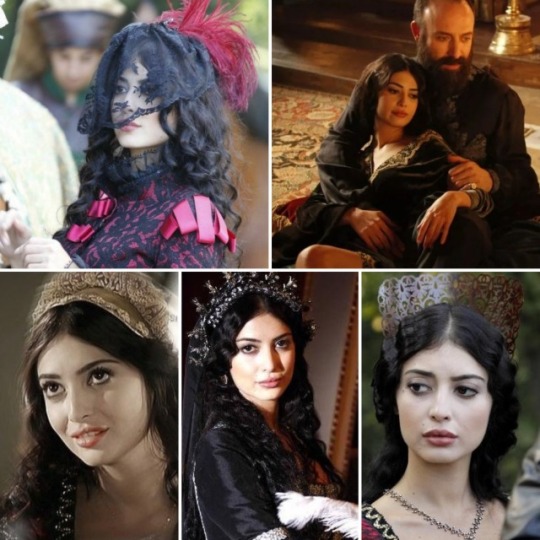
Aybige Hatun
A sorozatban Aybige Ayşe Hafsa Sultan unokahúga volt, a krími Sahib Giray kán lánya. Aybige eredetileg csak látogatóba érkezett Isztambulba, később azonban nagynénje szerette volna őt kedvenc unokája, Musztafa herceg feleségeként látni. Aybige azonban Bali Bégbe volt szerelmes és Musztafa is más után vágyakozott. Bali Béget végül majdnem kivégezték a szerelmük miatt, Aybige pedig apjával visszatért a Krímre.
Aybige történetszála szinte minden létező ponton hibádzik. Először is, Ayşe Hafsa sosem volt a Krími kán testvére, tehát a krími kán lánya sem lehetett az unokahúga. Emellett Sahib Giray kánnak bár több lánya volt, egyiket sem hívták Aybigének és egyik lánya sem utazott sosem Isztambulba. Az egész történetszál egyetlen igaz pontja, hogy Sahib Giray kán tényleg együttműködött Szulejmán szultánnal annak moldáv háborújában. Fontos megemlíteni ezen a ponton Bali Béget is. Bali Bég bár valós történelmi személy volt, de a legkisebb egyezés sincs a történelmi Bali Bég és a sorozat Bali Bége között. A valódi Bali Bég nem egy romantikus fickó volt, aki minden második nőbe beleszeretett, és akiért bolondultak a nők. Bali Bég egy kegyetlen hadvezér volt. És ha már Bali Bég szóba jött, ejtsünk néhány szót Musztafa hercegről is. Az ötlet, hogy Musztafát egy kán lányához akarják adni teljesen abszurd! II. Mehmed szultán uralkodása óta tilos volt a hercegeknek házasságot kötni, így Musztafa herceg sem köthetett senkivel házasságot. Az pedig, hogy Szulejmán támogatta volna az ötletet, már ha egyáltalán felmerült volna egy ilyen házasság, még nagyobb abszurdum. Szulejmán nem Musztafát akarta örökösének, így sosem adott volna a kezébe akkora hatalmat, mint a krími kán támogatása.
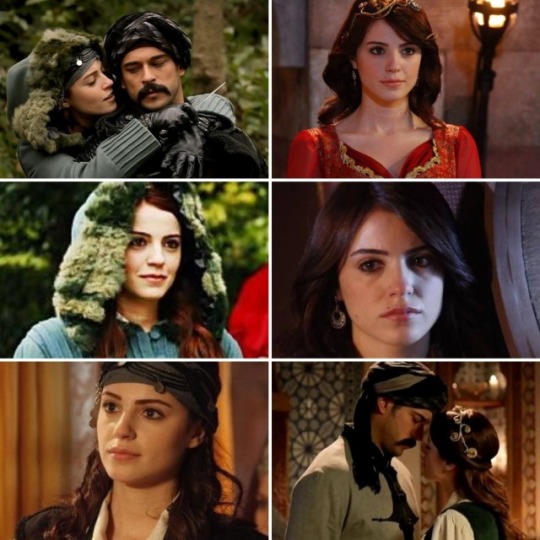
Firuze Hatun
A sorozatban Firuze egy perzsa kém volt, aki csodálatos képességeivel gyógyítani tudta a beteges Cihangir herceg fájdalmait, amivel kiérdemelte Hürrem szeretetét. Firuze azonban rút módon hálálta meg Hürrem kedvességét, ugyanis Szulejmán titkos szeretője lett, akibe a szultán halálosan beleszeretett. Végül Hürrem csak egy hajszállal volt képes felülkerekedni Firuzén, akit végül száműztek a palotából, így visszatérhetett Perzsiába.
A valóságban Szulejmán hűséges volt Hürremhez, monogám kapcsolatban éltek. Ha előfordult is alkalomadtán egy-egy egyéjszakás kaland, Szulejmán soha nem szeretett bele más nőbe, csak Hürremet szerette. Így a Firuze történetszál már itt el is bukott. A tény, hogy Firuze perzsa kém lett volna érdekes felvetés, bizonyára akadtak kémek minden birodalom királyi udvarába, azonban ők valószínűleg nem az ágyasok között rejtőztek. Az eunuchok például, sokkal nagyobb szabadsággal mozogtak, sokkal könnyebben lefizethetők voltak…
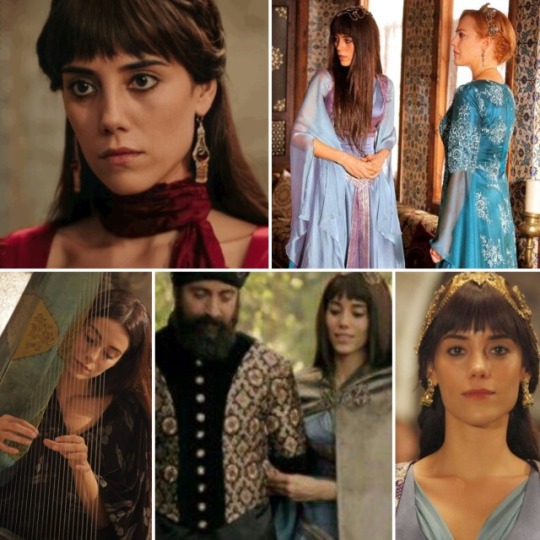
Huricihan Sultan
A sorozatban Huricihan Ibrahim Pasa és Hatice Sultan lánya volt, aki szülei halála után Beyhan Sultan palotájában nevelkedett. Onnan tért vissza Isztambulba, ahol beleszeretett elsőunokatestvérébe, Bayezid hercegbe. Szerelmükből kapcsolat, majd házasság lett a szultán engedélye nélkül. Huricihan Bayezid háremének feje lett és kapcsolata lassanként rendbejött Hürremmel és a szultánnal is. Huricihan végzete végül Szelim herceg ágyasa, Nurbanu lett, aki egy vita hevében leütötte őt, ezzel megölve.
A valóságban Hatice és Ibrahim Pasa sosem voltak házasok, így gyermekük sem született, tehát Huricihan sosem létezett. Ha létezett volna is, a már korábban említett okokból teljesen elképzelhetetlen lett volna, hogy Bayezid feleségül vegye őt akár titokban, akár nyíltan. Különösen tudva, hogy Bayezidnek nem volt sosem kiemelt ágyasa, minden gyermeke más nőtől született. Ilyen háttérrel nem valószínű, hogy valaha is feleségül akart volna venni bárkit. Hatice Sultannak bár valóban volt egy lánya, az 1510-1515 között született, így korban jóval megelőzte Bayezidet, és természetesen sosem volt semmi köze a herceghez és nem is Huricihannak hívták.
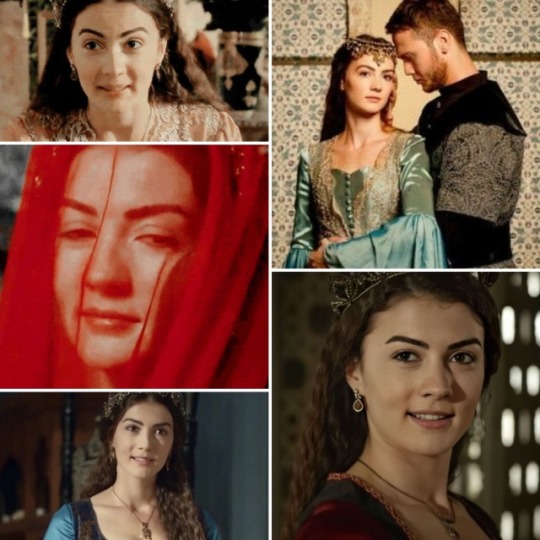
Mihrünissa Hatun
A sorozatban Mihrünissa Hayreddin Barbarossa flotta parancsnok lánya volt, akit édesapja küldött Musztafa herceg mellé tanácsadónak. Később a két fiatal egymásba szeretett és a szultán tudta nélkül egybe keltek. Idővel Mihrünissa életet adott Musztafa fiának, Mehmednek is. Miután Musztafa herceget és vele együtt fiát, Mehmedet is kivégezték, Mihrünissa a fővárosba ment és Hürrem szeme láttára elvágta a saját torkát.
A valóságban a már fent többszörösen részletezett okok miatt egy herceg sem köthetett házasságot, így Musztafa sem nősült meg soha. Emellett Barbarossának sosem volt Mihrünissa nevű lánya és Hayreddin Pasa sohasem volt Musztafa herceg támogatója. Ha azonban feltételeznénk is, hogy Mihrünissa létezett, nincs arra esély, hogy Hürrem szeme láttára lehetett volna öngyilkos. Musztafa herceg háreme Bursába vonult vissza, így a hárem egyik tagja sem utazhatott egyetlen percre sem a fővárosba, nemhogy a palotába, Hürrem elé. Így tulajdonképpen a Mihrünissa történet-szál 100%-ban kitaláció volt.
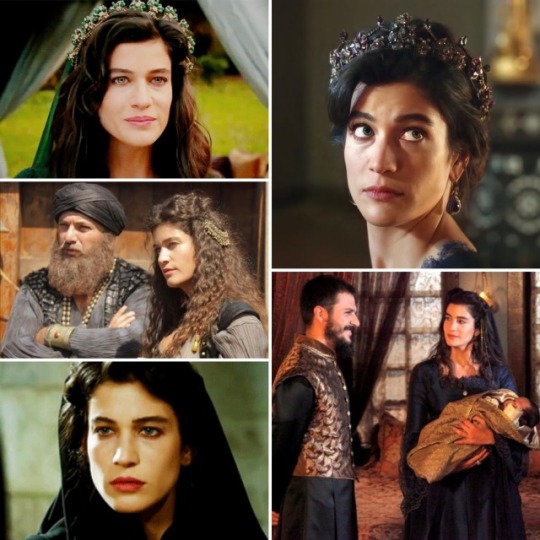
Nazenin Hatun
A sorozatban Nazenin Nurbanuval együtt érkezett Isztambulba, ahol aztán a menopauzával küszködő Hürrem maga küldte őt a szultán elé. Nazenin így a szultán ágyasa lett és hamarosan egy lánygyermeknek, Raziye Sultannak adott életet. Végül Hürrem utasítására Nurbanu ölte meg.
A valóságban, mint már sokszor mondtam, Szulejmán hűséges volt Hürremhez. Emellett Cihangir herceg 1531/2-es születése után Szulejmán nem nemzett több gyermeket, sem Hürremnek sem másnak. Az igaz, hogy volt egy Raziye nevű kislánya, azonban a gyermek 1520-ban néhány éves korában elhunyt egy járvány következtében.
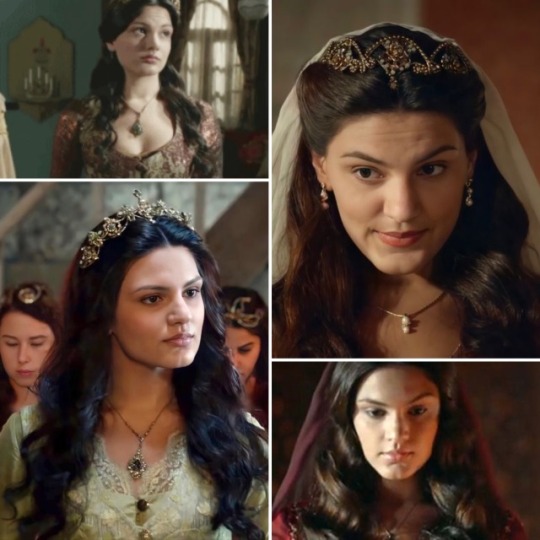
Meglepő valóságok
A sok kitalált karakter után azt gondolhatnánk, hogy az összes eunuch és kalfa kitalált karakter volt, hiszen meglehetősen keveset tudunk a háremről. Azonban ez nem igaz! Volt néhány történelmi ihletésű karakter, mint például Gazanfer Aga, aki bár létezett, és a valaha volt egyik legbefolyásosabb eunuch volt, nem Nurbanu hű embere volt, hanem II. Szelim szultáné. Gazanfer pályája csúcsát egyébként Safiye Sultan uralkodása alatt érte el.
Hasonlóan valós volt Canfeda Hatun is, aki Nurbanu leghűségesebb szolgálója volt és az egyik legbefolyásosabb kalfája korának. Igaz, Canfeda sorozatbeli karaktere, a történelmi Nurbanu két hűséges szolgálójának ötvözéseként született meg. Nurbanu fiatal korában, Szelim hercegi háremében nem Canfedával, hanem egy másik kalfával ismerkedett meg, aki élete végéig hűséges szolgálója maradt. Canfeda csak Szelim uralkodása alatt került képbe és vált Nurbanu fő segítőjévé.
Hozzájuk hasonlóan Afife Hatun karaktere is részben valós volt. Szulejmán szultán szoptatósdajkáját tényleg Afifének hívták és a szultán mindig tartotta a kapcsolatot az asszonnyal. Azonban Afife Hatun sosem költözött Isztambulba, hogy irányítsa a szultáni háremet, hanem egyszerű életet élt.
Gracia Mendes Nasi az utolsó évadban került bemutatásra, mint gazdag portugál zsidóasszony, aki portugál menekülteknek segített Isztambulba jutni. Később Gracia a nagyvezír Rüsztem Pasa szeretője lett, aminek köszönhetően szembe került Mihrimah szultánával. A valóságban Gracia Mendes igen jótét lélek volt, aki elkötelezett volt a zsidó hagyományok és zsidó testvérei iránt. Sosem volt Rüsztem szeretője és Mihrimah ellensége. Azonban a sorozathoz hasonlóan, Gracia a valóságban is élvezte a szultán támogatását és segítségével nagy fejlesztéseket vitt véghez Isztambul zsidó negyedében és nagyon sok menekültnek segített új életet kezdeni az Oszmán Birodalomban.
A sorozat utolsó évadának egyik legérdekesebb vendégszereplője Jagelló Anna volt, az egykori lengyel király lánya, az új lengyel király testvére. Bár az asszony valós történelmi személy volt, a történelmi Anna sosem utazott Isztambulba és sosem levelezett Hürrem szultánával. Azonban Hürrem többször is váltott levelet Anna édesanyjával Bona Sforzával, Anna édesapjával, I. Zsigmond lengyel királlyal, valamint Anna testvérével, a későbbi II. Zsigmond Ágost lengyel királlyal, sőt Anna másik testvérével Izabella, magyar királynővel is. Hürrem közbenjárásának köszönhetően Szulejmán uralkodása alatt meglehetősen jó, szinte baráti volt a viszony a Lengyel Királyság és az Oszmán Birodalom között.
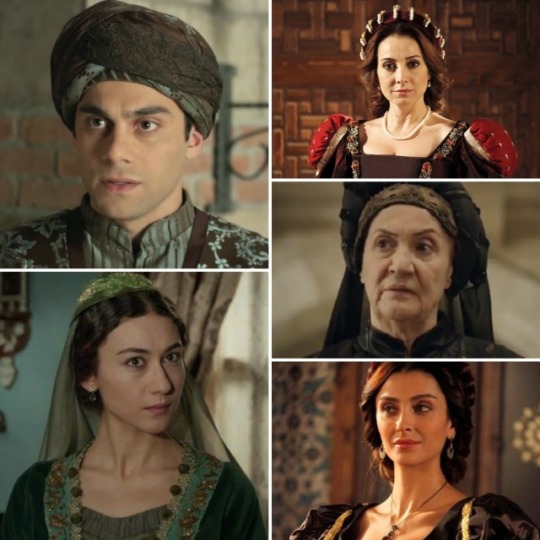
#selim ii#gazanfer agha#gazanfer#suleiman the magnificent#safiye sultan#suleiman i#suleyman i#haseki hürrem sultan#hürrem sultan#nurbanu sultan#aybige hatun#ayse hafsa#ayse hafsa sultan#princess isabella#firuze#firuze hatun
104 notes
·
View notes
Text
LISTA POSTACI
Sułtan Sulejman Wspaniały Wolny
Sułtanka Hürrem Wolna
Sułtanka Şah Wolna
Książę Cihangir Wolny
Sułtanka Mihrimah Wolna
Sułtanka Esmahan (Córka sułtanki Şah i Lütfi Paszy) Wolna
Rüstem Pasza Wolny
Lütfi Pasza (Mąż sułtanki Şah, ojciec sułtanki Esmehan) Wolny
Malkoçoğlu Balı Bey Wolny
Ayas Pasza Wolny
Hüsrev Pasza Wolny
Süleyman Pasza Wolny
Afife Hatun (Skarbniczka i zarządczyni haremu) Wolna
Firuze Hatun (Perska księżniczka, faworyta Sulejmana) Wolna
Mercan Ağa (Służący sułtanki Şah) Wolny
Fahriye Hatun (Służąca sułtanki Hürrem) Wolna
Sümbül Ağa Wolny
Şeker Ağa Wolny
Pargalı İbrahim Pasza Wolny
Sułtanka Hatice Wolna
Gülfem Hatun Wolna
Sułtanka Huricihan Wolna
Książę Osman Wolny
Książę Mehmed Wolny
Cihan Hatun (Faworyta księcia Mehmeda) Wolna
Książę Mustafa Wolny
Sułtanka Mahidevran Wolna
Taşlıcalı Yahya Bey (Poeta, przyjaciel księcia Mustafy) Wolny
Fidan Hatun (Służąca sułtanki Mahidevran) Wolna
Rümeysa Hatun (Faworyta księcia Mustafy) Wolna
Ayşe Hatun (Faworyta księcia Mustafy) Wolna
Książę Selim Wolny
Nurbanu Hatun Wolna
Dil��ah Hatun (Faworyta księcia Selima) Wolna
Książę Bajazyd Wolny
Rana Hatun (Faworyta księcia Bajazyda) Wolna
Tuğrul Bey (przyjaciel Księcia) Wolny
Defne Hatun (Faworyta księcia Bajazyda) Wolna
Nigar Kalfa Wolna
Sułtanka Beyhan Wolna
Matrakçı Nasuh Wolny
Ferhad Pasza (Mąż sułtanki Beyhan) Wolny
Ebussuud Efendi (Sędzia Stambułu) Wolny
Barbaros Hayreddin Pasza (Admirał Imperium Osmańskiego, przyjaciel Mustafy) Wolny
6 notes
·
View notes
Text
Ahırına giden hatun, keçilerinden birinin dördüz doğurduğunu görünce büyük şaşkınlık yaşadı
Ahırına giden hatun, keçilerinden birinin dördüz doğurduğunu görünce büyük şaşkınlık yaşadı
Muğla‘nın Menteşe kazasında, ‘Saanen’ cinsi keçi, dördüz doğurdu. Keçinin sahibi Rana Otçu (35), dördüz doğumla birinci defa karşılaştığını belirterek, şaşkınlık ve memnunluğu bir arada yaşadığını söyledi.
Menteşe’nin kırsal Salihpaşalar Mahallesi’nde oturan, evli ve 3 evlat validesi çiftçi Rana Otçu’ya ilişkin ‘Saanen’ cinsi keçi, dördüz doğurdu. Keçilerinden birinin birinci sefer dördüz…
View On WordPress
0 notes
Text
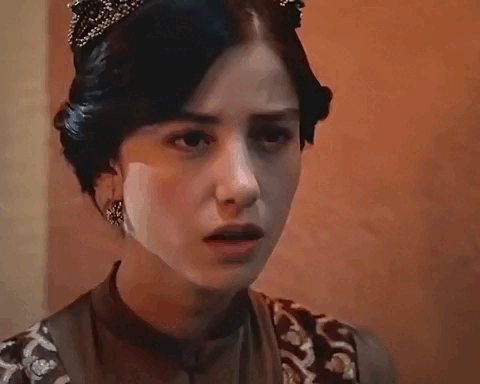
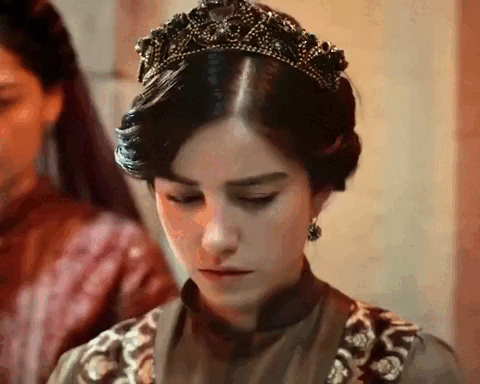
ꨄ Rana Sultan (Özge Gürel) — Magnificent Century Ep.129
13 notes
·
View notes
Text




This golden tiara was first worn by Mahidevran Sultan in the twenty-first episode of the third season of Magnificent Century. Five episodes later, the tiara is seen again on Hürrem Sultan. The tiara also makes two appearances in the fourth season, first on Gülfem Hatun in the third episode and then on Rana Sultan in the twenty-sixth episode.
#Muhteşem Yüzyıl#Magnificent Century#period drama#costume drama#historical drama#Mahidevran Sultan#Hürrem Sultan#Hurrem Sultan#Gülfem Hatun#Gulfem Hatun#Rana Sultan#recycled jewellery#reused jewellery
12 notes
·
View notes
Photo


(Almost) Every Costume Per Episode + Rana’s red headpiece in 4x11
#Muhteşem Yüzyıl#Magnificent Century#Muhtesem Yuzyil#mcedit#Rana Hatun#weloveperioddrama#perioddramaedit#costumeedit#4x11#An Accident in Manisa#wspaniałe stulecie#mc#costumes#costume edit#costume drama#costume set#costume series#Almost Every Costume Per Episode#historical drama#period drama#perioddrama#Özge Gürel#Awkward-Sultana
20 notes
·
View notes
Text



This golden and green tiara was first worn by Şah Sultan in the thirty-sixth episode of the third season of Magnificent Century. It appeared twice in the fourth season, first on Gülfem Hatun in the third episode and then on Rana Sultan in the twenty-sixth episode.
#Muhteşem Yüzyıl#Magnificent Century#period drama#costume drama#historical drama#Şah Sultan#Sah Sultan#Şah Sultan (Daughter of Hafsa)#Gülfem Hatun#Gulfem Hatun#Rana Sultan#reused jewellery#recycled jewellery
13 notes
·
View notes
Text
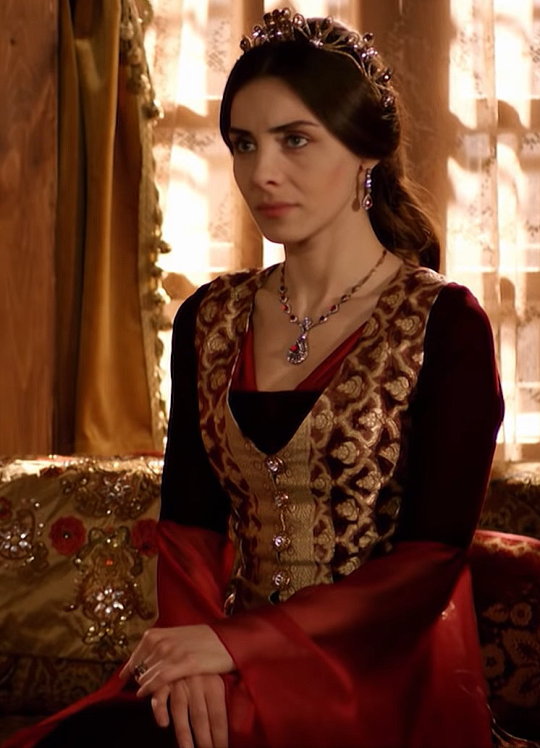
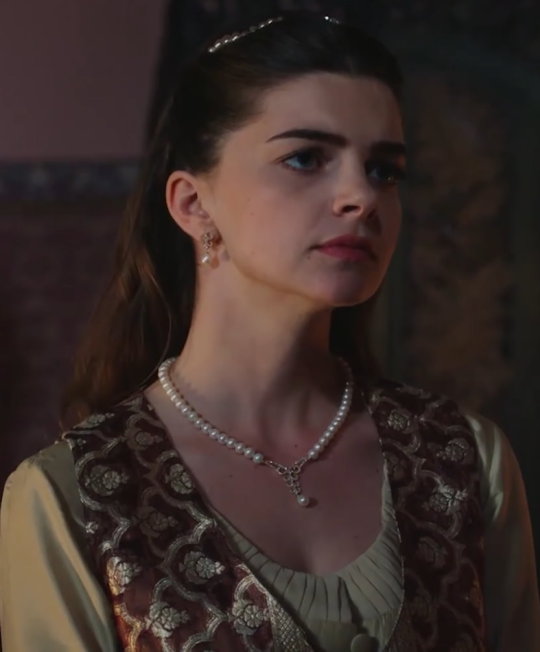
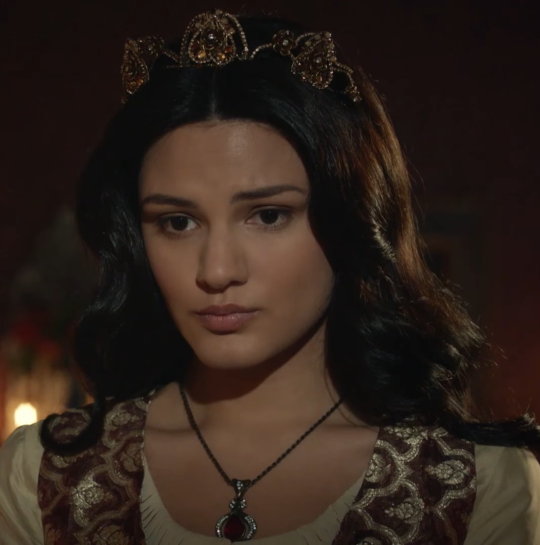

This brown and golden kaftan was first worn by Mahidevran Sultan in the twenty-second episode of the second season of Magnificent Century. It was worn again by Mihrimah Sultan in the thirty-third episode of the third season. The kaftan appears twice in the fourth season, first on Nazenin Hatun in the tenth episode and then on Rana Sultan in the twenty-sixth episode.
#Muhteşem Yüzyıl#Magnificent Century#period drama#costume drama#historical drama#Mahidevran Sultan#Mihrimah Sultan#Mihrimah Sultan (Daughter of Hürrem)#Nazenin Hatun#Rana Sultan#reused costumes#recycled costumes
14 notes
·
View notes
Text
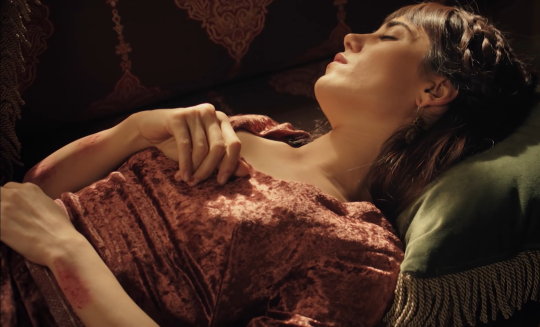
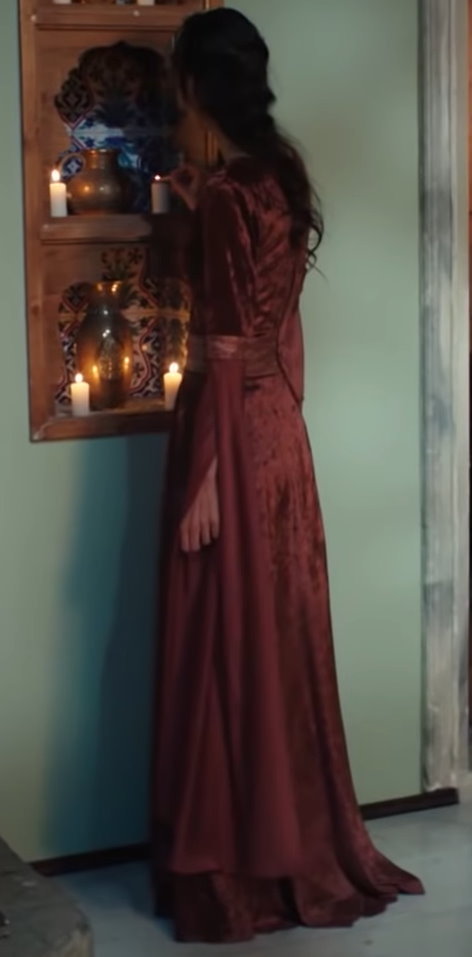
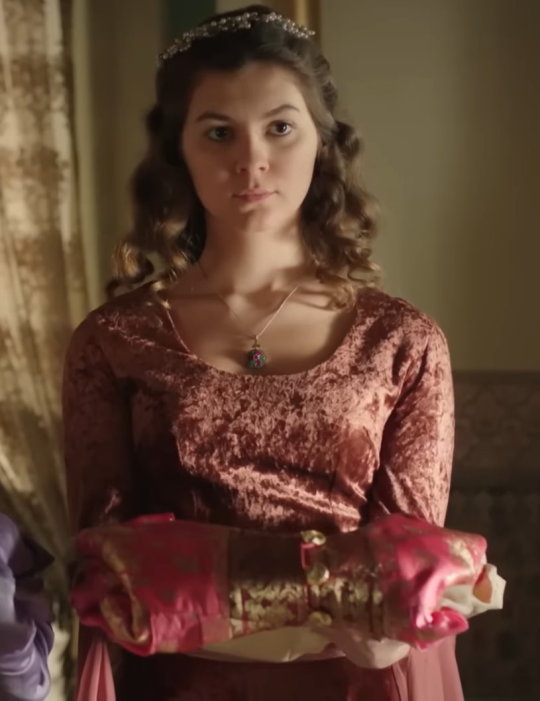


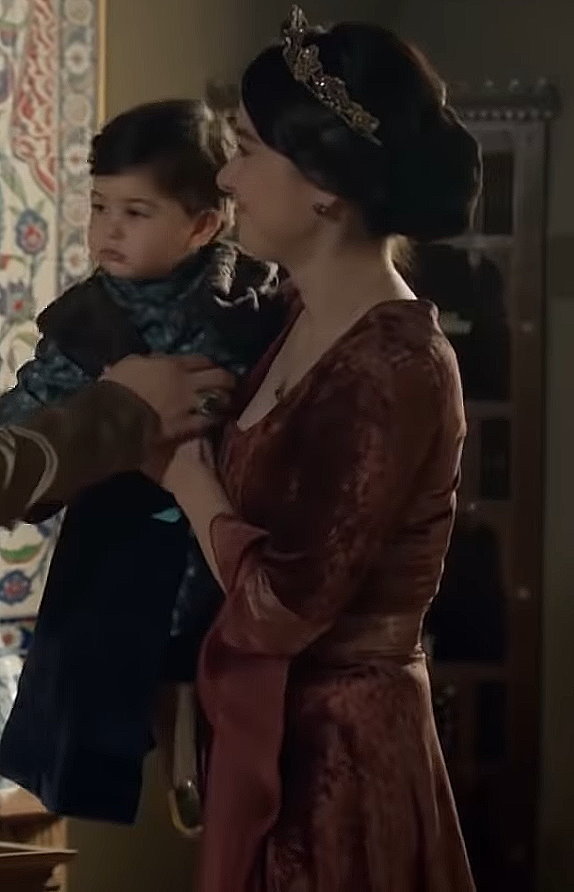
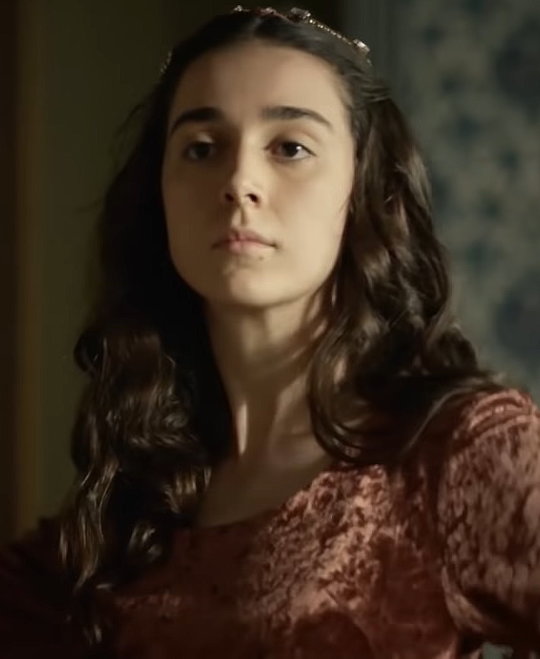
This red, brown and golden velvet dress was first worn by Firuze Hatun (Hümeyra) in the twelth episode of the third season of Magnificent Century. The dress was worn by two unnamed harem members in the twenty-ninth and thirty-fifth episode of the same season. Dilşah Hatun is seen in the dress in the fourth episode of the fourth season. Two episodes later the dress is worn by another unnamed harem member. It makes another appearance on Rana Sultan in the eighteenth episode. The dress is worn one last time in the thirty-fourth episode by an unnamed harem member.
#Magnificent Century#Muhteşem Yüzyıl#period drama#costume drama#historical drama#Firuze Hatun#Hümeyra#Unnamed Harem Members#Dilsah Hatun#Dilşah Hatun#Rana Sultan#recycled costumes#reused costumes
12 notes
·
View notes
Text
Master Post - Women
Themes
Costumes | Jewellery | Props
Valide Sultan
Hafsa Sultan
Halime Sultan
Handan Sultan
Kösem Sultan
Nurbanu Sultan
Safiye Sultan
Turhan Sultan
Haseki Sultan
Ayşe Sultan (Harem of Murad IV)
Dilaşub Sultan
Hümaşah Sultan (Harem of Ibrahim I)
Hürrem Sultan
Mahidevran Sultan
Muazzez Sultan
Sultanas by birth
Atike Sultan
Ayşe Sultan (Daughter of Kösem)
Ayşe Sultan (Daughter of Şehzade Bayezid)
Ayşe Hümaşah Sultan
Beyhan Sultan (Daughter of Hafsa)
Beyhan Sultan (Daughter of Turhan)
Bican Sultan
Dilruba Sultan
Esmahan Sultan
Fahriye Sultan
Fatma Sultan (Daughter of Hafsa)
Fatma Sultan (Daughter of Kösem)
Gevherhan Sultan (Daughter of Kösem)
Gevherhan Sultan (Daughter of Nurbanu)
Hanzade Sultan
Hatice Sultan (Daughter of Hafsa)
Hatice Sultan (Daughter of Şehzade Bayezid)
Hümaşah Sultan (Daughter of Safiye)
Huricihan Sultan
İsmihan Sultan
Kaya Sultan
Mihrimah Sultan (Daughter of Hürrem)
Mihrimah Sultan (Daughter of Şehzade Bayezid)
Nergisşah Sultan
Şah Sultan (Daughter of Hafsa)
Şah Sultan (Daughter of Nurbanu)
Concubine Sultanas
Defne Sultan
Farya Sultan/Farya Bethlen
Gülbahar Sultan
Mahfiruze Sultan
Meleksima Sultan
Mihrünnisa Sultan
Rana Sultan
Concubines & Harem Members
Afitap Hatun
Akile Hanim
Anna Hatun
Ayşe Hatun (Harem of Şehzade Mustafa)
Cihan Hatun
Dilşah Hatun
Efsun Hatun
Elanur Hatun
Elif Hatun (Harem of Şehzade Mustafa)
Fatma Hatun
Firdevs Hatun
Firuze Hatun
Gülfem Hatun
Gülnihal Hatun
Gülsen Hatun
Hanife Hatun
Hazal Hatun
Helena Hatun
Katerina Hatun
Mahfiruz Hatun
Nazenin Hatun
Neze Hatun
Nurbahar Hatun
Olga Hatun
Rümeysa Hatun
Sadıka Hatun
Sanavber Hatun
Şayeste Hatun
Yasemin Hatun
Zarife Hatun
Unnamed Harem Members
Servants
Afife Hatun
Canfeda Hatun
Cennet Hatun
Daye Hatun
Derya Hatun
Dudu Hatun
Elif Hatun (Servant of Gevherhan Sultan)
Emine Hatun
Esma Hatun
Eycan Hatun
Fahriye Kalfa
Fidan Kalfa
Gülbahar Kalfa
Gülperi Hatun
Gülşah Hatun
Gülşah Kalfa
Hatice Kalfa
Hircan Kalfa
Kumru Hatun
Lalezar Kalfa
Melek Hatun aka Madame Margaret (Servant of Farya Bethlen)
Melek Kalfa (Servant of Fatma Sultan)
Meleki Hatun
Menekşe Hatun
Nadia Hatun
Narin Kalfa
Nazlı Hatun
Nigar Kalfa
Nilüfer Hatun
Sedef Hatun
Ottoman Citizen
Armin Hatun
Cevher Hatun
Dilanur Hatun
Eleni Hatun
Esmanur Hatun
Ester Hatun
Foundation Ladies
Hanım Ağa
Kalika Hatun
Rakel Hatun
Sabiha Hatun
Zeynep Hatun
Unnamed Istanbul Citizens
Europeans
Anna Jagiellon
Carmina
Catherine of Brandenburg
Gabriella Sfenza De Feo
Gracia Mendes Nasi
Isabella Jagiellon
Princess Isabella Fortuna
Portia Gritti
Sara Hatun
Signora Benetto
Silvia Conterini
Unnamed European Characters
Other
Aybige Hatun
Eftelya Hatun
Rita Hatun
Saliha Hatun
#Muhteşem Yüzyıl#Muhteşem Yüzyıl: Kösem#Magnificent Century#Magnificent Century Kösem#Magnificent Century Kosem#Master Post
17 notes
·
View notes
Photo


(Almost) Every Costume Per Episode + Rana’s brown gown and pink lace kaftan in 4x13
#Muhteşem Yüzyıl#Magnificent Century#mcedit#Rana Hatun#Muhtesem Yuzyil#mc#wspaniałe stulecie#4x13#Price of Three Words#weloveperioddrama#perioddramaedit#costumeedit#costumes#costume edit#costume drama#costume set#costume series#Almost Every Costume Per Episode#historical drama#period drama#perioddrama#Özge Gürel#Awkward-Sultana
16 notes
·
View notes